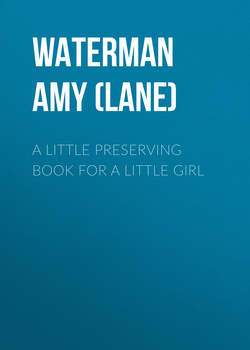Читать книгу A Little Preserving Book for a Little Girl - Waterman Amy Harlow (Lane) - Страница 25
CHAPTER III
JELLIES
ОглавлениеWhen mother gave Adelaide her first lesson in jelly making, Adelaide had visions. Jelly rolls, thin bread and butter sandwiches with jelly in between, soft boiled custards served in individual glasses with a spoonful of jelly on top, and many many other delicious dainties it would take too long to tell about passed before her active little mind. For some years now, Adelaide's mother had been using a small thin glass for her red currant jelly, and any other jelly of which she was especially choice. A glass measuring cup full of jelly was sufficient to fill three of these dainty glasses, and the beauty of these lay in the fact that you could put them on the table as they were. One little glass was sufficient to serve as a relish with cold meat or chicken for a family of four.
Mother thought that as Adelaide's quantities were all small she would let her use these small glasses exclusively for her jellies. Adelaide was delighted, and often held the little glasses up to the sunlight to see how clear and attractive the jelly was.
Red Currant Jelly
The large cherry currants were the ones mother bought, and she told Adelaide that they made the most delicious jelly. Adelaide emptied the currants into the colander, which she dipped up and down in a pan of clear cold water until the currants were thoroughly cleansed, then she drained them.
Picking them over but not removing the stems, Adelaide poured a few at a time into the saucepan (which contained two tablespoons of cold water), and mashed them with the wooden potato masher; this she continued to do until all the currants were used.
Placing the saucepan over the fire, she let the currants cook slowly until they looked white, stirring occasionally with the wooden spoon to prevent burning.
The little jelly bag attached to the wire frame fitted nicely over another large saucepan, and into this bag Adelaide poured the currants, letting them stand until all the juice had dripped.
Now she measured the juice and returned it to the original saucepan, which had been washed clean. Again she placed the saucepan over the fire and brought the juice to the boiling point; then she let it continue to boil rapidly for twenty minutes (mother said it was not necessary to stir this).
When Adelaide measured the juice she also measured to each cupful a cup of sugar. This she placed in an earthenware dish at the back of the range, or in the oven with the door open, to let it heat through gradually but not to brown. As soon as the juice had boiled sufficiently she added the heated sugar gradually and stirred with the wooden spoon until it was all dissolved; when it again came to the boiling point it jellied in about three minutes.
Adelaide worked very quickly now; she removed the saucepan from the fire, skimmed the jelly, poured it into a pitcher, and from there into the little sterilized glasses. These she placed in the sun and let them stand until the next day; they were then wiped around the tops and outsides carefully with a clean damp cloth, the jelly was covered with melted paraffin, the glass being shaken gently from side to side to exclude all air. Next came the labels, and then the jelly was stored away in the preserve closet. It was a beautiful color, and it made Adelaide's mouth water just to look at it.
Red Currant and White Currant Jelly
The red and white currants Adelaide found made the jelly a beautiful color and more delicate in flavor. These she washed carefully in the colander by dipping it up and down in a pan of clear cold water, then she picked them over without removing the stems. Into the saucepan she measured two tablespoons of water, added the currants a few at a time, and mashed them with the wooden potato masher until all were used. Next the saucepan was placed over the fire and the currants boiled until the red currants looked white. Adelaide did not forget to stir with the wooden spoon to prevent the currants from burning.
The jelly bag was ready and into this Adelaide poured the currants. She let the juice drip overnight, and the next morning measured it into the saucepan. To each cup of juice she measured a cup of sugar, which she placed in an earthenware dish on the back of the range to heat through, but not to brown. The juice Adelaide boiled for twenty minutes rapidly, then she added the sugar very gradually and stirred until it was dissolved. When it came to the boiling point it "jellied" very quickly, and Adelaide skimmed it, poured it into a pitcher, then into the small glasses at once, which were already sterilized.
Standing them in a sunny window she let them remain until the next day. With a clean damp cloth she wiped the top and outside of each glass carefully, poured melted paraffin over the jelly, shook each glass gently from side to side to exclude the air, pasted on the labels and, as usual, stored the jelly away in the preserve closet.
Red Currant and Raspberry Jelly
Of all the jellies this was mother's favorite.
Adelaide picked over the raspberries (looking in each centre to be sure there were no little worms), poured them into the colander, dipped them up and down in a pan of clear cold water to cleanse thoroughly, and after draining emptied them into the saucepan with two tablespoons of cold water. The currants were washed in the same manner as the raspberries, and Adelaide picked them over but did not remove the stems. These were added to the raspberries, and she mashed them all with the wooden potato masher.
